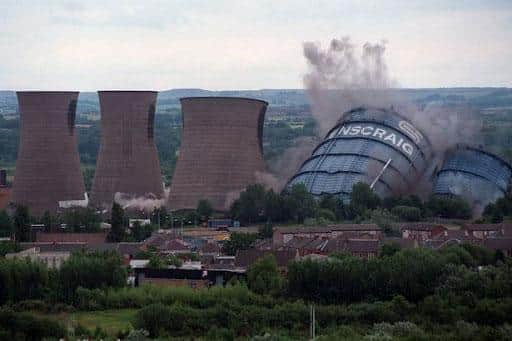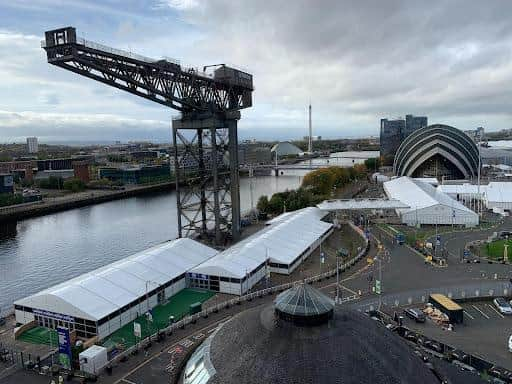COP26 travel blog: could renewables revitalise Scotland’s steel industry?
I’m old enough to remember when the giant towers of the Ravenscraig steel works that once loomed across the skyline for miles were razed in six seconds.
With it ended an era for Scotland’s industrial heartlands that broke the hopes and dreams for thousands in the area.
Many in Lanarkshire today will tell you the region has still never recovered.


The streets around the site may be quieter, cleaner, even more modern today. But it is clear there is still fire in the belly of many and a hope that a new dawn could soon break, thanks to the upcoming energy transition.
Ironically, it is those same skills forged in the steel works that are needed now. Processes have become cleaner, with plants in Finland for example producing a new generation of green steel, much of it destined to be used in the manufacturing of electric vehicles and ships.
Here in Motherwell, the 140 or so workers who make up the Liberty Steel Dalzell plant, have already played a part in providing materials for both tidal and wind turbines. They feel that with investment, this area could help lead Scotland’s renewables supply sector.
“We don’t actually make our steel in Motherwell, we have to be supplied, but what we try to do is keep our carbon footprint good,” explains Ross Clark, the President of the Community Union representing the staff.


“We try to make it in the UK and make the onward supply better. Green steel is something Sanjeev Gupta, our new owner, was interested in.
“His vision is to make steel from recycled steel in what is called an electric arc furnace process – basically melting down old steel and reproducing it into other steel and back in, so the carbon footprint is a lot better.”
And that, believes Ross, deserves more attention.
He says: “We have to get this transition because we’re going to need steel. We want Scotland supplying wind turbines, the tidal wave industry and we still have to make electric cars – this is how we can impact in the future but it’s a transitional period and we need heavy investment to get to that stage.
“There is opportunity there, lots of opportunity. We’ve faced perfect storms, Brexit, different things, energy costs are crippling us at the moment, but I’m always very optimistic.
“If they get the procurement right there is a successful future for the steel industry in Scotland.
“The carbon footprint from bringing it from the other side of the world to an island is, in my opinion, not sustainable.”
His enthusiasm is inspiring as I head towards Glasgow. Yet there’s no hiding how the big factories – Caterpillar, Marshalls and so on have gone. I can’t help but wonder if he is right, could decisions at COP26 really spark a new, clean industry for Scotland?
If we are to embrace sustainable energy in our homes, decarbonise our transport, will we not also need those skills on our doorstep as part of the creation of a smarter, cleaner grid?
One element of our greener energy system - the smart meter rollout - is really gathering momentum. Available for both homes and small businesses, they will play a key role in helping to decarbonise the nation’s energy use. This is because they will help to enable a smart energy system which will be able to better balance our energy demands, enabling more reliance on renewable energy, while also laying the groundwork for future green energy initiatives.
It is this type of thinking world leaders at COP26 will have on their mind as they consider our low carbon futures.
When I arrived at the UN Climate Conference venue in Glasgow a week before the event started , white modular style buildings were interlocked together and ran straight towards the main halls. People stood with clipboards and hard hats, workers in hi-vis jackets hammered and shouted.
All the way around was a tall black metal fence. You could peer through to see separate new entrances for Ministers and VIPs. Crates full of plastic water butts were being wheeled into the buildings. It was quite the operation.
Parents pushed prams along the riverbank, alongside dog walkers, joggers and people like me just out for a look.
Bothwell-man Kevin Cowan who was watching the spectacle, said “I think it’s great for the city to have it here. I know it’s a lot of disruption, but I think after the COVID situation it’s a boost for the businesses and so on all around it, so I think on balance it’s a good thing.
“It’s all about the climate and how things are changing, and if we get some meaningful dialogue around that – the key thing for me is it’s got to be about action, talk is cheap so what is it you are actually going to do that for me is the big thing.
But he added: “Every day we need to be more aware about what we are consuming, how we are consuming it, do we need to take long journeys and is that really necessary. I don’t think there is any silver bullet, I think it’s small things every day and just to be more aware of the things we are doing.”
Which is Scotland in a nutshell. Thinking big because we have too. Taking even small actions right now because we can.
But it is what we do next that will really count.
Join the energy revolution. Search: “Get a smart meter”.